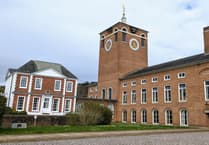SOMEWHERE in a bog north of Bude, a trickle of a stream seeps into a culvert, breaks free and spreads itself into one of the finest rivers in the British Isles.
The Tamar almost severs Devon and Cornwall, and, in doing so, strengthens the identity of both.
The meandering and beautiful river is the subject of a new book, Discovering the River Tamar. In it, author John Neale brings a wealth of fascinating detail to the surface.
Who knew that the 15th century Greystone Bridge on the road from Tavistock to Launceston was so called not because of any grey stone, but after Greyston Manor, which stood nearby.
Before traffic lights were placed at either end of the narrow bridge, it was the scene of many a stand-off between stubborn motorists. One such involved a farmer driving a large vehicle and a nurse, on her way home to Tavistock after a night shift.
As she was well over halfway across the bridge, she refused to budge. With no shift to do the next night, she returned to her car and read a nursing journal. Result: the farmer gave way. But the two later became friends, politely acknowledging each other along the route.
Horsebridge was once one of the more important crossings, but no more, as other bridges have taken the strain.
The Royal Inn at Horse Bridge was once known as The Packhorse as it was on a drovers' route. Legend has it that it was originally a nunnery, closed down on the orders of Charles II.
From there, the Tamar enters the industrial landscape of East Cornwall, including the former mining area of Stoke Climsland. The village post office is featured in a lovely photograph. The first postmaster was a Mr Crafter, and the picture shows the then postmaster, the splendidly named Mr Stumbles.
Nearby Kelly Bray, the book informs us, is one of the most changed places in the Tamar borderland and owes its existence to the railway terminus that was once there. A photograph shows the marked change in the look of the village.
From here, the river runs down to Gunnislake, once a cluster of houses by its Cornish bank.
During the civil war, the strategic importance of New Bridge was evident and more than 200 soldiers died in the a skirmish in the area.
New Bridge was once the closest point to Plymouth at which the river could be crossed.
Through Morwellham, Calstock and down to Saltash, the river spreads itself to run under the Tamar road and rail bridges and onward to meet Plymouth Sound.
But one bone of contention still rages. How do you pronounce 'Tamar'?
Well, a lifelong Launcestonian once told me that whenever television or radio referred to it as the River 'Tame-ah', he winced.
'It's pronounced Tamer,' he said. 'And we should know — it's our river!'
Discovering the River Tamar is itself a delightful discovery. The book is published by Amberley Publishing, price £12.99.




Comments
This article has no comments yet. Be the first to leave a comment.